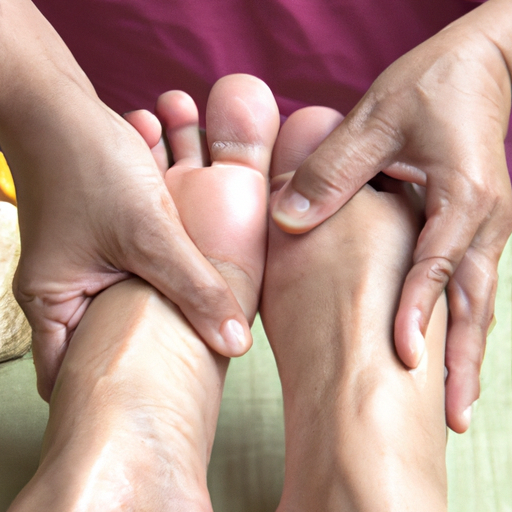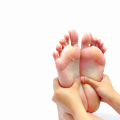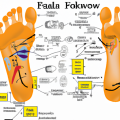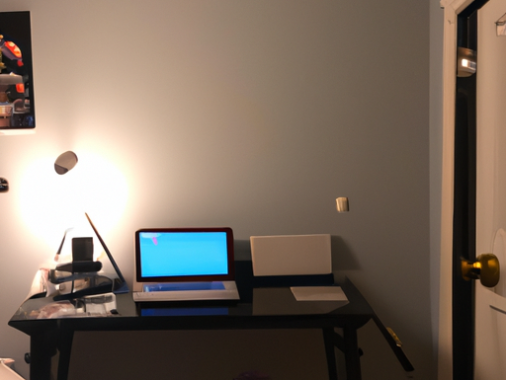-
Table of Contents
- Introduction
- The Benefits of Hand and Foot Reflexology
- Comparing the Techniques of Hand and Foot Reflexology
- Exploring the Origins of Hand and Foot Reflexology
- How to Choose the Right Reflexologist for Hand and Foot Reflexology
- The Science Behind Hand and Foot Reflexology
- The Pros and Cons of Hand and Foot Reflexology
- Exploring the Different Types of Hand and Foot Reflexology Treatments
- Q&A
- Conclusion
Introduction
Hand and foot reflexology are both ancient healing techniques that have been used for centuries to promote relaxation and healing. Both techniques involve applying pressure to specific points on the hands and feet to stimulate the body’s natural healing processes. While both techniques can be beneficial, it is important to understand the differences between them in order to determine which is best for you. This article will discuss the differences between hand and foot reflexology, as well as the benefits of each.
The Benefits of Hand and Foot Reflexology
Hand and foot reflexology is a form of alternative medicine that has been used for centuries to promote relaxation and healing. It is based on the belief that certain areas of the hands and feet correspond to different organs and systems in the body. By applying pressure to these areas, reflexologists can help to reduce stress, improve circulation, and promote overall health and wellbeing.
The benefits of hand and foot reflexology are numerous. It can help to reduce stress and tension, improve circulation, and promote relaxation. It can also help to reduce pain, improve sleep, and boost the immune system. Additionally, it can help to improve digestion, reduce fatigue, and improve overall energy levels.
Reflexology can also be used to treat a variety of conditions, including headaches, sinus problems, digestive issues, and menstrual cramps. It can also be used to help with anxiety, depression, and insomnia. Additionally, it can be used to help with chronic pain, such as back pain, neck pain, and joint pain.
Hand and foot reflexology is a safe and non-invasive form of therapy. It is generally considered to be safe for all ages and can be used in conjunction with other forms of treatment. It is important to note, however, that reflexology should not be used as a substitute for medical care.
Hand and foot reflexology is a great way to promote relaxation and healing. It can help to reduce stress, improve circulation, and promote overall health and wellbeing. It can also be used to treat a variety of conditions and can be used in conjunction with other forms of treatment. If you are looking for a safe and non-invasive way to promote relaxation and healing, hand and foot reflexology may be the perfect choice for you.
Comparing the Techniques of Hand and Foot Reflexology
Reflexology is a form of alternative medicine that involves applying pressure to specific points on the hands and feet. It is believed that these points correspond to different organs and systems in the body, and that stimulating them can help to promote healing and relaxation. Hand and foot reflexology are two of the most common forms of this therapy.
Hand reflexology is based on the idea that the hands are a map of the body. Each finger and area of the hand is believed to correspond to a different organ or system. During a hand reflexology session, the practitioner will use their fingers to apply pressure to specific points on the hands. This pressure is believed to stimulate the corresponding organs and systems in the body, helping to promote healing and relaxation.
Foot reflexology is based on the idea that the feet are also a map of the body. Each area of the foot is believed to correspond to a different organ or system. During a foot reflexology session, the practitioner will use their thumbs and fingers to apply pressure to specific points on the feet. This pressure is believed to stimulate the corresponding organs and systems in the body, helping to promote healing and relaxation.
Both hand and foot reflexology can be used to help promote healing and relaxation. However, there are some differences between the two techniques. Hand reflexology is generally considered to be more gentle and subtle than foot reflexology. This makes it a good choice for those who are sensitive to touch or who have a low pain threshold. Foot reflexology is generally considered to be more intense and stimulating than hand reflexology. This makes it a good choice for those who are looking for a more invigorating experience.
In conclusion, hand and foot reflexology are two of the most common forms of reflexology. Both techniques can be used to help promote healing and relaxation, but they have some differences. Hand reflexology is generally considered to be more gentle and subtle, while foot reflexology is generally considered to be more intense and stimulating. It is important to choose the technique that is best suited to your individual needs and preferences.
Exploring the Origins of Hand and Foot Reflexology
The practice of reflexology, which is the application of pressure to specific points on the hands and feet, has been used for centuries to promote relaxation and healing. While the exact origins of this practice are unknown, there is evidence that it has been used in various forms since ancient times.
The earliest known reference to reflexology dates back to 2330 BC, when an Egyptian physician named Imhotep wrote about the practice in his medical texts. He described the use of pressure on the feet and hands to treat a variety of ailments, including headaches, digestive issues, and even infertility.
In ancient China, reflexology was used as part of traditional Chinese medicine. It was believed that the body was made up of energy pathways, and that applying pressure to certain points on the hands and feet could help to unblock these pathways and restore balance to the body.
In India, the practice of reflexology was known as “Marma” and was used to treat a variety of ailments. It was believed that the body was made up of seven energy centers, and that applying pressure to certain points on the hands and feet could help to restore balance to these centers.
In the early 20th century, a doctor named William Fitzgerald developed a system of reflexology that he called “zone therapy.” He believed that the body was divided into ten zones, and that applying pressure to certain points on the hands and feet could help to restore balance to these zones.
Today, reflexology is used by many people around the world as a way to promote relaxation and healing. While the exact origins of this practice are unknown, it is clear that it has been used in various forms since ancient times.
How to Choose the Right Reflexologist for Hand and Foot Reflexology
When it comes to choosing the right reflexologist for hand and foot reflexology, it is important to take the time to research and find a qualified and experienced practitioner. Here are some tips to help you make the right decision.
First, it is important to find a reflexologist who is certified and licensed. This ensures that the practitioner has the necessary qualifications and experience to provide quality care. It is also important to check the practitioner’s credentials and references to ensure they are qualified and experienced in the field.
Second, it is important to find a reflexologist who is knowledgeable about the different techniques used in hand and foot reflexology. This will ensure that the practitioner is able to provide the best possible treatment for your needs.
Third, it is important to find a reflexologist who is comfortable with the techniques used in hand and foot reflexology. This will ensure that the practitioner is able to provide the best possible treatment for your needs.
Finally, it is important to find a reflexologist who is willing to listen to your concerns and answer any questions you may have. This will ensure that the practitioner is able to provide the best possible treatment for your needs.
By taking the time to research and find a qualified and experienced reflexologist, you can ensure that you receive the best possible treatment for your needs. With the right practitioner, you can be sure that you will receive the best possible care and results.
The Science Behind Hand and Foot Reflexology
Hand and foot reflexology is a form of alternative medicine that is based on the idea that certain areas of the hands and feet are connected to other parts of the body. This connection is believed to be due to the presence of nerve endings in the hands and feet that are connected to other parts of the body.
The practice of reflexology is based on the concept of “reflex points”, which are believed to be areas of the hands and feet that correspond to specific organs and systems in the body. By applying pressure to these points, practitioners believe that they can stimulate the corresponding organs and systems, and thus promote healing and balance in the body.
The scientific basis for reflexology is still being studied, but there is some evidence to suggest that it may be effective in treating certain conditions. For example, studies have shown that reflexology may be effective in reducing pain, improving circulation, and reducing stress.
In addition, research has suggested that reflexology may be beneficial in treating certain conditions such as headaches, digestive issues, and menstrual cramps. However, more research is needed to confirm these findings.
Overall, hand and foot reflexology is a form of alternative medicine that is based on the idea that certain areas of the hands and feet are connected to other parts of the body. While the scientific basis for reflexology is still being studied, there is some evidence to suggest that it may be effective in treating certain conditions.
The Pros and Cons of Hand and Foot Reflexology
Hand and foot reflexology is a form of massage therapy that has been used for centuries to promote relaxation and healing. It is based on the idea that certain areas of the hands and feet correspond to different organs and systems in the body. By applying pressure to these areas, reflexologists believe they can help to reduce stress, improve circulation, and promote overall health and wellbeing.
Pros
1. Relaxation: Hand and foot reflexology can be a great way to relax and unwind after a long day. The massage techniques used can help to reduce tension and stress, and can even help to improve sleep quality.
2. Improved Circulation: By stimulating the reflex points on the hands and feet, reflexology can help to improve circulation throughout the body. This can help to reduce pain and inflammation, as well as improve overall health.
3. Holistic Approach: Reflexology takes a holistic approach to health and wellbeing, focusing on the body as a whole rather than just treating individual symptoms. This can be beneficial for those looking for a more natural approach to health and wellbeing.
Cons
1. Lack of Evidence: While there is some evidence to suggest that reflexology can be beneficial, there is still a lack of scientific evidence to support its use. This means that it may not be suitable for everyone.
2. Cost: Hand and foot reflexology can be expensive, depending on the practitioner and the length of the session. This may make it inaccessible for some people.
3. Risk of Injury: As with any massage therapy, there is a risk of injury if the reflexologist is not experienced or if the pressure applied is too strong. It is important to ensure that the practitioner is qualified and experienced before undergoing a session.
Overall, hand and foot reflexology can be a great way to relax and promote overall health and wellbeing. However, it is important to consider the pros and cons before deciding if it is right for you.
Exploring the Different Types of Hand and Foot Reflexology Treatments
Reflexology is a type of massage therapy that focuses on applying pressure to specific points on the hands and feet. It is believed that these points correspond to different areas of the body, and that applying pressure to them can help to relieve stress and tension, improve circulation, and promote overall health and wellbeing.
Hand reflexology is a type of treatment that involves applying pressure to specific points on the hands. These points are believed to correspond to different organs and systems in the body, and applying pressure to them can help to reduce stress and tension, improve circulation, and promote overall health and wellbeing. Hand reflexology can be used to treat a variety of conditions, including headaches, digestive issues, and even depression.
Foot reflexology is a type of treatment that involves applying pressure to specific points on the feet. These points are believed to correspond to different organs and systems in the body, and applying pressure to them can help to reduce stress and tension, improve circulation, and promote overall health and wellbeing. Foot reflexology can be used to treat a variety of conditions, including headaches, digestive issues, and even depression.
In addition to hand and foot reflexology, there are also other types of reflexology treatments available. These include ear reflexology, which involves applying pressure to specific points on the ears, and facial reflexology, which involves applying pressure to specific points on the face. Each of these treatments is believed to have its own unique benefits, and can be used to treat a variety of conditions.
No matter which type of reflexology treatment you choose, it is important to find a qualified practitioner who is experienced in the technique. A qualified practitioner will be able to assess your individual needs and provide the best treatment for you. It is also important to remember that reflexology is not a substitute for medical care, and should not be used to diagnose or treat any medical condition.
Q&A
1. What is reflexology?
Reflexology is a type of massage therapy that focuses on applying pressure to specific points on the feet, hands, and ears. It is believed that these points correspond to different parts of the body, and that applying pressure to them can help to reduce stress and improve overall health.
2. What are the benefits of reflexology?
Reflexology can help to reduce stress, improve circulation, and promote relaxation. It can also help to reduce pain, improve sleep, and boost the immune system.
3. Is reflexology safe?
Yes, reflexology is generally considered to be safe. However, it is important to consult with a qualified reflexologist before beginning any treatment.
4. How long does a reflexology session last?
A reflexology session typically lasts between 30 and 60 minutes.
5. What should I expect during a reflexology session?
During a reflexology session, the reflexologist will use their hands to apply pressure to specific points on the feet, hands, and ears. They may also use massage techniques to help relax the body and reduce stress.
6. Is there a difference between hand and foot reflexology?
Yes, there is a difference between hand and foot reflexology. Hand reflexology focuses on applying pressure to specific points on the hands, while foot reflexology focuses on applying pressure to specific points on the feet.
7. Which is better, hand or foot reflexology?
The answer to this question depends on the individual and their needs. Some people may find that hand reflexology is more effective for them, while others may find that foot reflexology is more effective. It is best to consult with a qualified reflexologist to determine which type of reflexology is best for you.
Conclusion
In conclusion, it is difficult to definitively say which is better, hand or foot reflexology. Both have their own benefits and drawbacks, and it is ultimately up to the individual to decide which is best for them. It is important to consult with a qualified reflexologist to ensure that the treatment is tailored to the individual’s needs.




